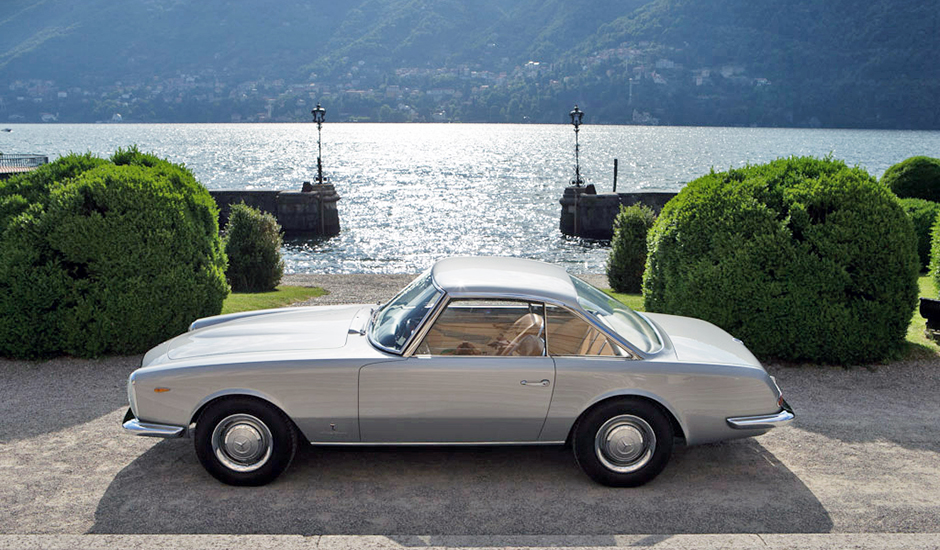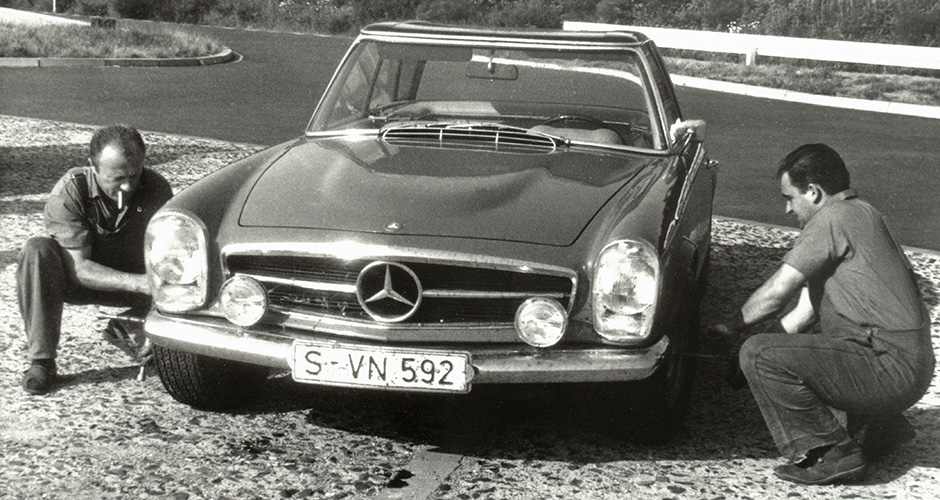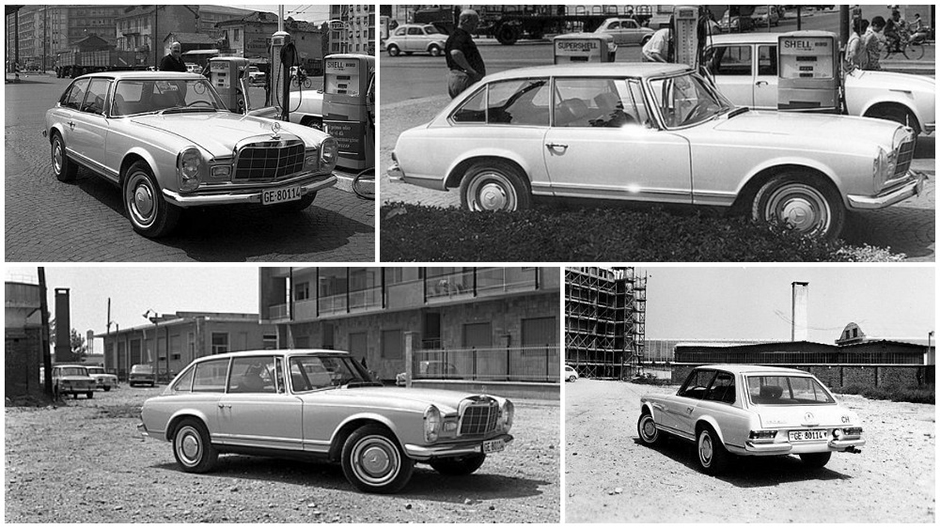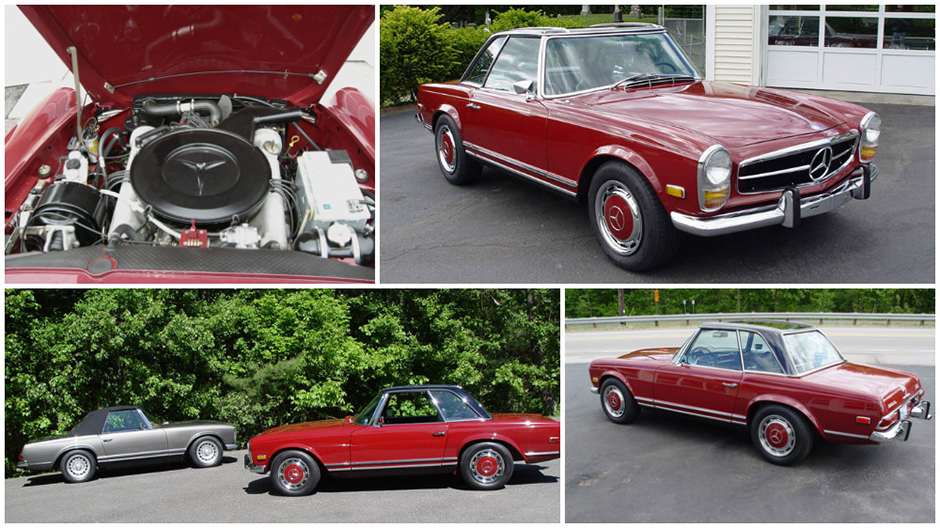
The Italians weighed in on the Pagoda’s design by creating this particularly attractive and well balanced design. Pininfarina’s 230SL ‘Coupe’ featured a roof that was decidedly fixed. Other interpretations would follow although often with less success.
Variations on the theme:
Improving the Pagoda?
While the demonstrably Teutonic design of the new 230SL was indeed attractive and the mechanical specification reasonably compelling, over the years there have been those who felt there was room for improvement. Variations on the theme ranged from the sublime to, shall we say, the rather heavy handed. We have a look at some of the more interesting efforts.
The most notable interpretation of what a Pagoda could look like emerged from the studios of Pininfarina.
The first attempt to vastly improve the Pagoda’s modest performance came from within Mercedes-Benz in 1967. Erich Waxenberger, Mercedes-Benz’ renowned development engineer and the fellow behind the epic 300SEL 6.3, couldn’t shake the vision of a 230SL fitted with his beloved 300hp 6.3 liter V8. The one-off 630SL he and his staff created absolutely destroyed the Pagoda design brief of an agile, refined, Grand Touring car for quick and comfortable Continental motoring. One was constructed and after harrowing tests at the Nurburgring, the car was crushed. Others have tried to improve the Pagodas performance and we present three of those efforts below Waxi’s brute.

Waxenberger’s monster 6.3 liter SL rests during tests at the Nurburgring. It was a misguided effort and we see one of the many front tire changes being completed; the front tires were destroyed after only 9 laps of the 14 mile Nurburgring’s Nordschleife (“North Loop”).
Frua and Pininfarina Concepts
Could the original taught and aesthetically pure Pagoda shape be improved? Contrary to North American manufacturers’ incessant and often contrived fiddling of their original designs, Mercedes-Benz left the Pagoda’s shape alone for the car’s entire production life. Post 1966 US models received DOT mandated side marker lights and of course our cars were fitted with sealed beam headlamps. Bumper guards were an option but that was it for cosmetic variations. The fact that the sheetmetal remained unchanged for 7 years reinforced the strength of the original design.
This isn’t to say that the entire automobile styling community was convinced the shape could not be improved, or at least given some additional utility. The most notable interpretation of what a Pagoda could look like emerged from the studios of Pininfarina. Managed during the Pagoda’s era by Sergio Pininfarina, the firm was responsible for most of Ferrari’s extraordinary designs in the ’60s. Their creation using an early 230SL achieved the impossible by retaining much of the original design’s Teutonic crispness but in an elongated and subtly sensual manner. It was and remains a stunning 230SL.
‘Utility’ was not an intended characteristic when the Pagoda was conceived. I suppose it was all relative to the other sports/grand touring cars on the market. Yes, two people and a moderate amount of luggage – fitted luggage was an option – could tour Europe briskly and comfortably but trunk and interior space was limited. At least one Pagoda owner required more space than the original design could provide, much more. For this client Frua, an Italian styling house known for designs generally less harmonious than the house of Pininfarina, created a bespoke 230SL. The result was interesting to say the least. While the rear 3/4 view preserved much of the Pagodas charm the treatment of the nose was, well…atrocious.

Frua’s bespoke 230SL wagon is certainly unique and not entirely objectionable but the nose treatment destroys the design. There was a reason Mercedes-Benz eschewed the vertical star for an understated enameled badge all the SLs. Integrating 2/3 of a Fintail grille and a modified sedan bumper spoils an otherwise pleasing design
3.5 V8 refinement
Perhaps inspired by the brutal factory 6.3 mule, experienced restorer Hatch and Son’s created a sublime transformation of a 280SL using period M116 3.5 V8 drivetrain. This is a more successful result and provides about 40 extra horsepower and a similar increase in torque. Note the beautifully integrated 15 inch wheels and wheel covers. Hatch constructed one automatic and one 4 speed edition. And no, despite pleas from interested buyers, he is not interested in constructing any more.

Aside from the clever 15″ wheels one would never know what lies under the hood of the superb Hatch and Sons 280SL 3.5. The firm constructed two cars, an automatic and a 4-speed manual. Carefully engineered ngine install appears factory.
roy spencer/editor mercedesheritage
photograpy/hatch and sons – daimler media – blogspot.com – ralph kesting – mechatronik